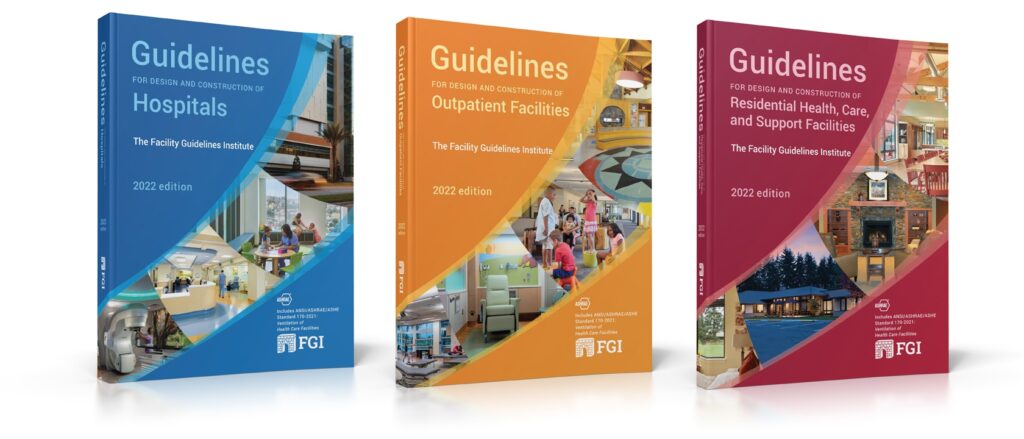FGI Bulletin #19
FGI Launching E-Commerce Site and Digital Library for the 2022 Guidelines

Those interested in purchasing the 2022 Guidelines for Design and Construction will soon have a convenient new way to access the documents with the upcoming launch of FGI’s dedicated e-commerce site and digital licensing platform. Debuting in April, the platform will be hosted directly at https://shop.fgiguidelines.org/, making all of FGI’s publications and content available in a single location.
“FGI’s new commerce-enabled site will provide a user-friendly checkout process, and the digital licensing platform will deliver a new suite of tools to increase productivity in a functional, streamlined experience for companies and individuals who frequently use the Guidelines documents,” says Chief Executive Officer Douglas S. Erickson.
Tools available to Guidelines subscribers through the new platform will include:
- Annotation and highlighting of the licensed content;
- Bookmarking of frequently used sections;
- Searchable and hyperlinked text for locating specific information quickly;
- Direct access to published errata, formal interpretations, and application guidance from relevant sections of the Guidelines documents;
- A secure, easy-to-use cart and checkout system for purchasing single- and multiple-user licenses; and
- Automatic application of bundling discounts during checkout.
Subscribers to the 2018 and 2014 editions of the Guidelines documents will be able to renew their subscriptions on MADCAD through June 30, 2022, and MADCAD will continue servicing active subscriptions through June 30, 2023. Digital licenses to the 2018 and 2014 editions will be available for purchase on the FGI website beginning July 1, 2022.
The planned release date of the 2022 Guidelines for Design and Construction documents has been delayed due to printer-side supply chain issues. At this time, FGI anticipates both the digital licenses and paperbacks will be available for purchase in April. Subscribers to the FGI Bulletin will be the first to be notified when the 2022 Guidelines are released.
FGI Seeking Volunteers for the 2026 Health Guidelines Revision Committee
Are you passionate about health and residential care? Would engaging in meaningful work with some of the most dedicated people in health and residential care facility operations; clinical services; and planning, design, and construction inspire and nourish you? If so, the Health Guidelines Revision Committee (HGRC) may be the right opportunity for you.
Every four years, more than 100 volunteers are selected to join the HGRC, the multidisciplinary body responsible for revising and updating the Guidelines for Design and Construction standards. Members of the HGRC are divided into three document groups (Hospital, Outpatient, and Residential) that collectively update the documents by identifying text sections needing improvement, proposing revisions to the Guidelines, and reviewing and voting on proposals and comments submitted by the public at large.
Time commitments for HGRC members fluctuate over the course of the four-year revision cycle, with activity heaviest during proposal and comment periods and lightest when manuscripts are being prepared for public comment and publication. HGRC members are expected to attend three annual meetings and contribute to regularly scheduled document group calls. Many HGRC members also choose to participate in topic-focused subcommittees to enrich their volunteer experience.
If you are interested in joining the 2026 Health Guidelines Revision Committee, complete this downloadable 2026 HGRC candidate questionnaire and email it and your current résumé to Managing Editor Heather Livingston here. Applications will be accepted through May, and appointments will be announced in the fall.
Three New 2018 Guidelines Interpretations Issued
In three recent instances, FGI convened an interpretation committee of at least five Health Guidelines Revision Committee (HGRC) members to develop a formal interpretation of language in the 2018 Hospital and Outpatient Guidelines. Formal interpretations are intended to explain the meaning or intent of language in the Guidelines that may be ambiguous, unclear, or conflict with other sections of the Guidelines.
2018 Hospital Guidelines
Electrical receptacles in medical/surgical patient rooms
“What is the intent of the requirement for two receptacles on every wall of an inpatient medical/surgical patient room?” asked a Guidelines user last fall. A patient room had been designed with six walls, two or three of which would have no receptacles (e.g., exterior glass wall, entrance wall with sliding glass doors, bathroom wall with a sliding door).
The interpretation committee convened to consider this question agreed that the basic intent of the HGRC was to require the minimum number of receptacles at the patient bed location indicated by NFPA 99: Health Care Facilities Code and NFPA 70: National Electrical Code. To clarify this, they recommended updating the receptacle location requirements for most patient room types in Table 2.1-1 (Electrical Receptacles for Patient Care Areas in Hospitals) to read, “Devices shall be located to support clinical functions and patient and visitor needs,” rather than specifying locations for the receptacles. This update also supports room designs that are not simply rectangular with four well-defined walls.
This change to Table 2.1-1 (Electrical Receptacles for Patient Care Areas in Hospitals) will appear in the 2022 Guidelines for Design and Construction of Hospitals.
Windows in behavioral and mental health facilities
Another interpretation committee responded to the query, “Does Section 2.5-7.2.2.5 (2) apply to both interior and exterior windows in patient care areas in a behavioral health unit or facility?” The text in question, in the architectural details section on windows in the chapter on psychiatric hospitals, reads as follows in the 2018 Hospital Guidelines:
*2.5-7.2.2.5 Windows
…
(2) To prevent opportunities for suicide, self-harm, and escape, the entire window system and the anchorage for windows and window assemblies, including frames, glazing, and hinges and locking devices for operable windows, shall meet the following requirements:
(a) Designed to resist impact loads of 2,000 footpounds applied from the inside
(b) Tested in accordance with AAMA 501.8: Standard Test Method for Determination of Resistance to Human Impact of Window Systems Intended for Use in Psychiatric Applications
The inquirer noted that the testing method specified appeared to apply only to exterior assemblies. The interpretation committee agreed the text in Section 2.5-7.2.2.5 (2) was intended to apply only to exterior windows. To clarify this point, they suggested adding the green head shown below. This clarification will appear in the 2022 Hospital Guidelines.
(2) Exterior windows located in patient care areas or areas used by patients. To prevent opportunities for suicide, self-harm, and escape, the entire window system and the anchorage for windows and window assemblies, including frames, glazing, and hinges and locking devices for operable windows, shall meet the following requirements:
2018 Hospital and Outpatient Guidelines
Ventilation of Class 1 mobile/transportable medical units
A question about HVAC requirements revealed some confusing text in the Guidelines requirements for mobile units in Chapter 2.8 in the 2018 Hospital Guidelines and Chapter 2.13 in the 2018 Outpatient Guidelines. The query was, “Is it the intent of [Hospital document] sections 2.8-8.2.1 (HVAC Systems—General) and 2.8-8.2.1.2 (Class 1 units) to require Class 1 mobile units to meet all the standards of ANSI/ASHRAE/ASHE Standard 170: Ventilation of Health Care Facilities?”
After considering discussions the 2022 Hospital Document Group had about this section, the interpretation committee concluded that Class 1 mobile units do not have to meet the requirements of ASHRAE 170: Ventilation of Health Care Facilities. The intent was for the mechanical requirements for these units, which do not house interventional procedures, to control the space to achieve patient and staff comfort.
The resulting changes to the 2018 text shown in green will appear in both the Hospital and Outpatient documents in the 2022 edition of the Guidelines.
2.8-8.2 Heating, Ventilation, and Air-Conditioning (HVAC) Systems
2.8-8.2.1 GeneralHVAC systems shall comply with the requirements in Section 2.1-8.2 (HVAC Systems) as modified in this section:
2.8-8.2.1.1 HVAC equipment, ductwork, and related equipment shall be installed in accordance with NFPA 90A: Standard for the Installation of Air-Conditioning and Ventilating Systems.
2.8-8.2.1.2 Class 1 units. Mobile/transportable medical units that are limited to provision of noninvasive diagnostic and treatment services without use of anesthetics shall meet the following mechanical requirements:…(3) Where procedures or patients require positive or negative ventilation for infection prevention, the medical unit shall meet the ventilation requirements in Part 3 (ANSI/ASHRAE/ASHE 170: Ventilation of Health Care Facilities).(4) (3) HVAC ductwork. Air-handling duct systems shall meet the requirements of NFPA 90A: Standard for the Installation of Air-Conditioning and Ventilating Systems.
Clarification of 2018 Outpatient Guidelines Errata
An error made in an earlier version of the 2018 Outpatient Guidelines errata sheet has now been corrected. You can find the updated sheet on the Guidelines errata page on the FGI website. Look for the footnote corrections for Table 2.1-2 (Station Outlets for Oxygen, Vacuum, Medical Air, and Instrument Air Systems in Outpatient Facilities).

